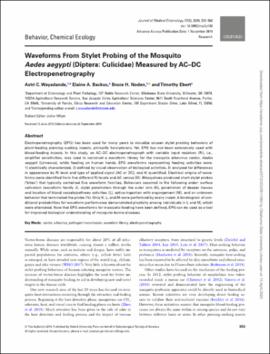| dc.contributor.author | Wayadande, Aastri C. | |
| dc.contributor.author | Backus, Elaine A. | |
| dc.contributor.author | Noden, Bruce H. | |
| dc.contributor.author | Ebert, Timothy | |
| dc.date.accessioned | 2022-04-12T13:29:41Z | |
| dc.date.available | 2022-04-12T13:29:41Z | |
| dc.date.issued | 2020 | |
| dc.identifier | oksd_noden_waveformsfromstylet_2020 | |
| dc.identifier.citation | Wayadande, A. C., Backus, E. A., Noden, B. H., & Ebert, T. (2020). Waveforms from stylet probing of the mosquito Aedes aegypti (Diptera: Culicidae) measured by AC-DC electropenetrography. Journal of Medical Entomology, 57(2), pp. 353-368. https://doi.org/10.1093/jme/tjz188 | |
| dc.identifier.uri | https://hdl.handle.net/11244/335134 | |
| dc.description.abstract | Electropenetrography (EPG) has been used for many years to visualize unseen stylet probing behaviors of plant-feeding piercing-sucking insects, primarily hemipterans. Yet, EPG has not been extensively used with blood-feeding insects. In this study, an AC-DC electropenetrograph with variable input resistors (Ri), i.e., amplifier sensitivities, was used to construct a waveform library for the mosquito arbovirus vector, Aedes aegypti (Linneaus), while feeding on human hands. EPG waveforms representing feeding activities were: 1) electrically characterized, 2) defined by visual observation of biological activities, 3) analyzed for differences in appearance by Ri level and type of applied signal (AC or DC), and 4) quantified. Electrical origins of waveforms were identified from five different Ri levels and AC versus DC. Mosquitoes produced short stylet probes ('bites') that typically contained five waveform families. Behaviors occurred in the following order: surface salivation (waveform family J), stylet penetration through the outer skin (K), penetration of deeper tissues and location of blood vessels/pathway activities (L), active ingestion with engorgement (M), and an unknown behavior that terminated the probe (N). Only K, L, and M were performed by every insect. A kinetogram of conditional probabilities for waveform performance demonstrated plasticity among individuals in L and M, which were alternated. Now that EPG waveforms for mosquito feeding have been defined, EPG can be used as a tool for improved biological understanding of mosquito-borne diseases. | |
| dc.format | application/pdf | |
| dc.language | en_US | |
| dc.publisher | Oxford University Press (OUP) | |
| dc.relation.ispartof | Journal of Medical Entomology, 57 (2) | |
| dc.relation.uri | https://www.ncbi.nlm.nih.gov/pubmed/32104891 | |
| dc.rights | This material has been previously published. In the Oklahoma State University Library's institutional repository this version is made available through the open access principles and the terms of agreement/consent between the author(s) and the publisher. The permission policy on the use, reproduction or distribution of the material falls under fair use for educational, scholarship, and research purposes. Contact Digital Resources and Discovery Services at lib-dls@okstate.edu or 405-744-9161 for further information. | |
| dc.subject.mesh | Aedes | |
| dc.subject.mesh | Animals | |
| dc.subject.mesh | Electrophysiological Phenomena | |
| dc.subject.mesh | Feeding Behavior | |
| dc.subject.mesh | Female | |
| dc.title | Waveforms from stylet probing of the mosquito Aedes aegypti (Diptera: Culicidae) measured by AC-DC electropenetrography | |
| dc.date.updated | 2022-04-07T14:09:30Z | |
| osu.filename | oksd_noden_waveformsfromstylet_2020.pdf | |
| dc.description.peerreview | Peer reviewed | |
| dc.identifier.doi | 10.1093/jme/tjz188 | |
| dc.description.department | Entomology and Plant Pathology | |
| dc.type.genre | Article | |
| dc.type.material | Text | |
| dc.subject.keywords | vector | |
| dc.subject.keywords | arbovirus | |
| dc.subject.keywords | electropenetrography | |
| dc.subject.keywords | pathogen transmission | |
| dc.subject.keywords | waveform library | |
| dc.subject.keywords | Infectious Diseases | |
| dc.subject.keywords | Vector-Borne Diseases | |
| dc.subject.keywords | 06 Biological Sciences | |
| dc.subject.keywords | 11 Medical and Health Sciences | |
| dc.subject.keywords | Tropical Medicine | |
| dc.identifier.author | ScopusID: 6603001611 (Wayadande, AC) | |
| dc.identifier.author | ScopusID: 7004182886 (Backus, EA) | |
| dc.identifier.author | ORCID: 0000-0002-0096-370X (Noden, BH) | |
| dc.identifier.author | ScopusID: 6601968347 (Noden, BH) | |
| dc.identifier.author | ScopusID: 7102788743 (Ebert, T) | |
| dc.identifier.author | ScopusID: 6603548555 (Hillyer, J) | |
